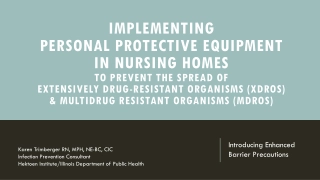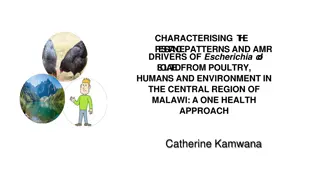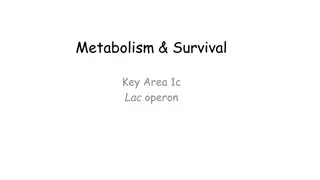Antimicrobial Activity of Moringa Oleifera, Aloe Vera on Multidrug-Resistant Bacteria
Antibiotic resistance poses a significant global health threat, leading to increased mortality and morbidity. This study investigates the antimicrobial properties of Moringa Oleifera, Aloe Vera, and Warbugia Ugandensis on multidrug-resistant Escherichia coli, Pseudomonas aeruginosa, and Staphylococcus aureus. Methods include agar diffusion assays to determine zones of inhibition and MIC and MBC values. The research aims to provide insight into potential alternative treatments for combating drug-resistant bacteria.
Download Presentation

Please find below an Image/Link to download the presentation.
The content on the website is provided AS IS for your information and personal use only. It may not be sold, licensed, or shared on other websites without obtaining consent from the author.If you encounter any issues during the download, it is possible that the publisher has removed the file from their server.
You are allowed to download the files provided on this website for personal or commercial use, subject to the condition that they are used lawfully. All files are the property of their respective owners.
The content on the website is provided AS IS for your information and personal use only. It may not be sold, licensed, or shared on other websites without obtaining consent from the author.
E N D
Presentation Transcript
ANTIMICROBIAL ACTIVITY OF MORINGA OLEIFERA, ALOE VERA AND WARBUGIA UGANDENSIS ON MULTIDRUG RESISTANT ESCHERICHIA COLI, PSEUDOMONAS AERUGINOSA AND STAPHYLOCOCCUS AUREUS Peter G. Kirira*, Anne Muhuha, Stanley Kang ethe MOUNT KENYA UNIVERSITY KENYA Presentation at the 6thHealth and Scientific Conference & International Health Exhibition and Trade Fair, 29th-31stMarch, 2017, Bujumbura, Burundi 1
INTRODUCTION Antibiotic resistance is inability of drug(s) to kill a microbe that was previously used to treat the same microbe New resistance mechanisms have developed and have spread widely (due to use and misuse of antibiotics) challenging our ability to manage common infectious diseases resulting to mortality and morbidity of individuals. (WHO, 2015) Development of new antibiotics on a downward trajectory 2
INTRODUCTION cont The rising prevalence of multi-drug resistant bacterial strains and recent emergence of strains with deprived sensitivity to antibiotics raises the scope of unmanageable microbes (Rojas et al., 2006). Sub therapeutic use of antibiotics on domestic animals (Kivuvi et al, Kariuki et al; 2006). The therapeutic properties of plants have been evaluated by many studies all over the world giving promising results (Adriana et al., 2007). 4
OBJECTIVES Broad Objective To determine the antimicrobial activity of W. ugandensis,M. oleifera, and A. vera on multi drug resistant S. aureus, P. aeruginosa and E. coli. Specific objectives 1) To determine the zone of inhibition of W. ugandensis,M. oleifera, and A. vera on multidrug resistant S. aureus, P. aeruginosa and E. coli through agar diffusion assay. 2) To determine the Minimum Inhibitory Concentration (MIC) and Minimum Bactericidal Concentration (MBC) of W. ugandensis,M. oleifera, and A. vera on multidrug resistant S. aureus, P. aeruginosa and E. coli. 5
METHODOLOGY Study Area The multi-drug resistant micro-organisms were obtained from Microbiology National Public Health Reference Laboratory, Nairobi All the experiments were carried out at Mount Kenya University research laboratories Plant Materials 200 grams of Aloe vera leaves, Moringa oleifera leaves and Warbugia ugandensis were harvested from their natural habitat 6
METHODS cont Anti-bacterial Assay Disc diffusion method was used to determine anti-microbial activity by measuring zones of inhibition in millimeters. Serial dilution of the extract was done to determine the Minimum inhibitory Concentration(MIC) (Rahman et al., 2009). 8
METHODS cont Minimum Bactericidal Concentration(MBC) was also determined. Controls Standard bacteria ;S. aureus (ATCC 26923), P. aeruginosa (ATCC 27853)and E. coli (ATCC 29218) were used and tetracycline(25 ug) was used as a conventional antimicrobial for both gram positive and gram negative bacteria 9
DATA ANALYSIS Raw data was entered in Microsoft excel and later exported to Minitab version 17.0 for statistical analysis. Data was subjected to descriptive statistic and expressed as mean standard error of mean (SEM). p value less or equals to 0.05 was considered significant. ANOVA was used to determine statistical difference among different treatment groups followed by Tukey s post hoc test for pairwise comparison between different treatment groups. 10
RESULTS: METHANOLIC EXTRACTS Zones of inhibition (mm) Group Treatment Standard Test Standard Test Standard Test S. aureus S. aureus P. P. E. coli E. coli aeruginos aeruginos a a Negative 4% DMSO 0.00 0.00 0.00 0.00 0.00 0.00 0.00 0.00 0.00 0.0 0.00 0.00 g f f e 0f e control Positive Tetracycline 24.56 0.3 19.00 1.0 29.11 0.3 25.33 0.1 25.44 0. 21.00 1.0 4a 4a 9a 7a 24a 4a control W. ugandensis 11.00 0.0 9.89 0.11 9.17 0.17 8.33 0.17 10.00 0. 9.17 0.12 Methanol Extract 0c b b b 00b bc 400 g/ml M.oleifera 12.00 0.0 8.50 0.24 9.00 0.00 8.50 0.25 9.33 0.3 9.00 0.00 0b bcde bc b 3c bdc 400 g/ml 9.00 00bc8.06 0.06 Aloe vera 10.67 0.3 8.89 0.26 10.00 0. 9.78 0.15 3cd bcd b 00b b 400 g/ml 11
RESULTS FOR AQUEOUS EXTRACTS Zones of inhibition (mm) Group Treatment Standar Test Standard Test Standard Test d S. aureus P. P. E. coli E. coli S. aeruginos aeruginos aureus a a Negative control Distilled water 0.00 0.0 0.00 0.00 0.00 0.00 0.00 0.00 0.00 0.0 0.00 0.0 0d 23.56 0. 34a d g h 0f 24.44 0. 24a 0c 20.00 1. 04a 18.00 1.0 4a 28.11 0.3 9a 24.33 0.1 7a Positive control Tetracycline W. ugandensis 8.00 0.0 7.56 0.06 7.67 0.17 7.50 0.00 8.00 0.0 7.72 0.1 Aqueous Extract 0b bc cd cde 0c 9b 400 g/ml M. oleifera 8.00 0.0 8.33 0.14 8.50 0.29 8.50 0.14 8.50 0.0 7.89 0.2 0b b b b 0b 2b 400 g/ml Aloe vera 8.00 0.0 7.50 0.00 7.83 0.17 7.83 0.19 8.00 0.0 7.50 0.0 0b bc c c 0c 0b 400 g/ml 13
MIC AND MBC Methanol extract ( g/ml) Aqueous extract ( g/ml) W. ugandensis M. oleifera A. vera W.Ugandensis M. oleifera A. vera Bacteria strain MIC MBC MIC MBC MIC MBC MIC MBC MIC MBC MIC MBC Standard S. aureus 180 360 180 360 180 360 180 380 180 360 180 360 Test S. aureus 180 360 180 360 180 360 160 320 180 360 180 360 Standard P. aeruginosa 180 360 180 360 180 360 180 380 180 360 180 360 Test P. aeruginosa 180 360 160 320 180 360 380 400 180 360 180 360 Standard E. coli 180 360 180 360 180 360 180 380 180 360 180 360 Test E. coli 160 320 160 320 160 320 380 400 160 320 260 400 15
RECOMMENDATION The extracts of W. ugandensis, M. oleifera and A. vera should be investigated further to determine synergistic effects. Purification and isolation of the bioactive compounds . Using different parts of the plants e.g bark, roots, seeds. 16
Acknowledgements EAHRC / KEMRI for partial conference support MKU for funding the project Audience Ms. Muhuha MSc. Candidate 17























